#neoaves
Text
So we don't know, exactly, how most birds are related to each other
so, for fun:
more polls that can't get derailed
had to cut the et al for space, sorry
enjoy
#neoaves#biology#phylogeny#cladistics#evolutionary biology#ornithology#birds#birblr#sciblr#polls#science polls#hypotheses
232 notes
·
View notes
Text
Perplexicervix paucituberculata Mayr et al., 2023 (new species)
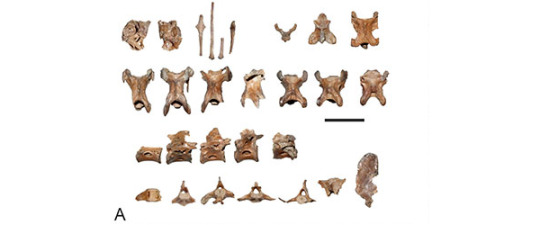
(Type specimen of Perplexicervix paucituberculata [scale bar = 10 mm], from Mayr et al., 2023)
Meaning of name: paucituberculata = little tuberculate [in Latin]
Age: Eocene (Ypresian), 54.6‒55 million years ago
Where found: London Clay Formation, Essex, U.K.
How much is known: Partial skeleton including vertebrae and fragments of the skull. Partial skeletons of two other individuals may also belong to this species.
Notes: P. paucituberculata was an unusual bird that had small bumps covering its neck vertebrae. This feature is shared with the only other species of Perplexicervix that had been previously named, P. microcephalon, as well as with Dynamopterus tuberculatus (a possible close relative to modern seriemas), both of which are from the Eocene of Germany. In fact, the neck vertebrae of P. microcephalon are even more extensively coated in these bumps than those of P. paucituberculata. Similar structures have not been observed in extant birds and their function is unknown. When they were first noticed in fossil birds, it was thought that they may have been the result of an ancient disease that no longer affects birds today. However, the fact that all known specimens of Perplexicervix preserving neck vertebrae have these bumps suggests that they were instead a typical part of their anatomy.
What type of extant bird Perplexicervix was most closely related to is also unclear. Similarities to waterfowl (specifically screamers) had been noted in earlier studies, and the type specimen of P. paucituberculata had been briefly mentioned in a previous paper as an early waterfowl. New specimens, however, indicate that Perplexicervix did not have the characteristic lower jaw anatomy shared by both waterfowl and landfowl. The describers of P. paucituberculata instead note that some of its bones bear noticeable resemblance to those of bustards, a group of often large, ground-dwelling birds that live in Afro-Eurasia and Australasia today. A close relationship with bustards would be very noteworthy if upheld by future research, given that early members of the bustard lineage are otherwise unknown from the Paleogene Period.
Reference: Mayr, G., V. Carrió, and A.C. Kitchener. 2023. On the "screamer-like" birds from the British London Clay: an archaic anseriform-galliform mosaic and a non-galloanserine "barb-necked" species of Perplexicervix. Palaeontologia Electronica 26: 33. doi: 10.26879/1301
#Palaeoblr#Birblr#Dinosaurs#Birds#Perplexicervix paucituberculata#Eocene#Europe#Neoaves#2023#Extinct
37 notes
·
View notes
Text

Day 14- Prehistoric animal from your home country.
I picked the Saint Bathans Heron AKA Mataku otagoense, this was quite challenging to do since I don't really draw birds often and there were barely any resources- I couldn't even find a single reconstruction.
Prompts
#art#my art#digital art#paleoart#dinovember#paleontology#birblr#palaeoblr#archosaurs#dinosaurs#theropods#coleurosaurs#maniraptorans#avialans#neornithines#aves#birds#neognaths#neoaves#aequornithes#pelicaniformes#ardidae#herons#matuku#matuku otagonese#saint bathans heron#saint bathans fauna#nz wildlife#Aotearoa#ok that's enough tags
18 notes
·
View notes
Link
Following up on my 2016 post about Hawaiian solitaires, I wrote up this short blog post tonight to meditate (belatedly) on the USFWS memo from last September which delisted this once endangered, now extinct, bird. More posts are in the pipeline - I promise.
#Archosaurofiles#Kāma'o#Thrushes#Turdidae#Passeriformes#Neoaves#Birds#Maniraptorans#Coelurosaurs#Theropods#Dinosaurs#Conservation
25 notes
·
View notes
Text
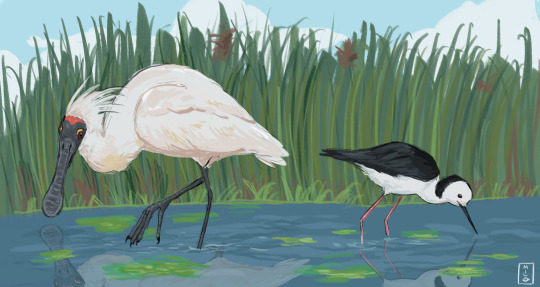
Royal spoonbill (Platalea regia) and pied stilt (Himantopus leucocephalus) by @webberwoof.
Excellent commission experience: Milo is very kind and friendly, and got this one done super fast.
I found it hard to choose which birds to commission, but when I saw a royal spoonbill and pied stilt wading together, I thought that deserved a drawing. (IRL, royal spoonbills aren't yet in breeding plumage around here, but I like the look better, so there.)
#birds#art#webberwoof#royal spoonbill#pied stilt#black-billed spoonbill#Platalea regia#spoonbill#Platalea#Threskiornithidae#Pelecaniformes#white-headed stilt#Himantopus leucocephalus#stilt#Himantopus#Recurvirostridae#Charadriiformes#Neoaves#Neognathae#commission#that's right mothers and folders I am a patron of the Arts
1 note
·
View note
Text
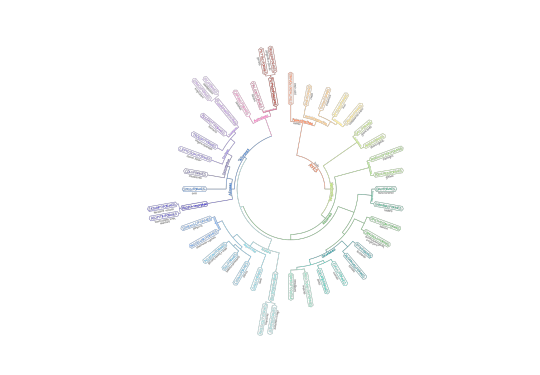
1 note
·
View note
Text
do you ever feel like the world is still recovering from the apocalypse even after 65 million years?
that whatever's alive now hasn't truly had the time to reach the heights of what came before yet, as the echoes of their burrow-dwelling ancestors keep leaving their mark in all of them?
i saw a group of birds fly overhead in a v-formation today but for a second it looked like it was one big winged animal
and now im feeling deeply melancholic over the fact that there was a time were flying archosaurs of such a size truly were around
ill never see an azdarchid fly, and it hurts
#ak goes insane#nostalgia for a past you never experienced#azdarchid#but alas#not really#just neoave birds
1 note
·
View note
Text

With recent advances in genetic sequencing and analysis, we now have a pretty good idea of how most modern vertebrate animals are related to each other. One of the biggest remaining mysteries in vertebrate evolution (and a major theme of my own research), however, is the relationships among the major groups of living birds.
There are some things that we all agree on about the bird family tree (which in some cases were already recognized before the rise of genetic studies), a big one being that modern birds can be divided into two major branches: Palaeognathae (ostriches, emus, and their close relatives) and Neognathae (all other living birds). Neognathae is in turn divided into Galloanserae (chickens, ducks, and their close relatives) and Neoaves (all remaining birds, which constitute 95% of living bird diversity).
Despite birds being one of the most intensely studied animal groups, however, essentially none of the large-scale genetic analyses that have been done on them so far have agreed with each other regarding how the major groups within Neoaves are related.
A new study by Stiller et al. (2024) might represent a big step forward in solving this mystery. Their results suggest that Neoaves can be divided into four major groups.
Mirandornithes: Flamingos and grebes. Stiller et al. found that all other members of Neoaves are probably more closely related to each other than to this group.
Columbaves: Consisting of two major subgroups, Otidimorphae (cuckoos, bustards, and turacos) and Columbimorphae (pigeons, sandgrouse, and mesites). Notably, Columbimorphae has been found by some earlier studies to be more closely related to Mirandornithes, but a second paper that was published on the same day by some of the same authors as Stiller et al. (2024) reported evidence that this previous result was probably caused by misleading similarities between the genetic sequences of Columbimorphae and Mirandornithes.
Elementaves: Consisting of Gruiformes (cranes and their close relatives), Charadriiformes (shorebirds), Strisores (hummingbirds, swifts, nightjars, and their close relatives), Phaethoquornithes (many waterbirds, including penguins, albatrosses, and herons), and the engimatic hoatzin. The exact relationships among these groups are still somewhat unclear; for example, Stiller et al. found the hoatzin to be most closely related to gruiforms and shorebirds (as had been suggested by an earlier study), but support for this result was not high. The hoatzin remains the single most difficult bird species to place in the bird family tree. The name Elementaves was newly coined by Stiller et al., referring to the fact that this group includes species specialized for life in the water, on the ground, and in the air (corresponding to the classical elements of water, earth, and air), as well as birds named after the sun ("fire"), such as the tropicbird genus Phaethon (Ancient Greek for "sun") and the sunbittern. This means that there is now a scientific basis for parodying Avatar: The Last Airbender using birds.
Telluraves: A big group consisting primarily of tree-dwelling birds, including songbirds, parrots, woodpeckers, kingfishers, and the various groups of birds of prey. An interesting result found by Stiller et al. is that owls are likely closely related to accipitrimorphs (hawks, eagles, vultures, etc.), which not all previous genetic studies had supported.
Stiller et al. (2024) provide further evidence for some bird relationships found by earlier analyses, but their results still doesn't exactly match those of any single previous study, so what makes this different from all those attempts that came before it? One is the amount of data. The genetic dataset analyzed by Stiller et al. was many times larger (both in terms of sequence length and the types of genes examined) than any study of this sort that had previously been done on birds. They also included over 360 bird species, which is more than what most previous studies had. Furthermore, they ran numerous tests to determine how the amount of data, number of species, and types of genes analyzed affected their findings, and in doing so were able to show that most of their results were relatively robust, or at least better supported than alternative hypotheses.
Another point of contention regarding the evolution of Neoaves is when the group originated. Were there already many neoavian lineages around during the Late Cretaceous, or did they mostly diversify following the mass extinction event that ended it? In the 2000s and early 2010s, studies trying to estimate the ages of bird groups based on rates of genetic evolution tended to find an older origin for Neoaves, but the majority of newer studies favor a younger origin, with most or all modern neoavian groups appearing after the Cretaceous (though one paper from earlier this year by a different team of authors advocated for older ages). Informed by recent studies on fossil birds, the results of Stiller et al. add further support for a more recent, mainly post-Cretaceous diversification of Neoaves (which I happen to think is more plausible than deep Cretaceous origins).
This almost certainly won't be the last word on these controversies by any means. However, at the moment I'm willing to tentatively consider Stiller et al. (2024) the closest we've gotten to approximating the true family tree of birds, and that is not a declaration I'd make lightly.
18 notes
·
View notes
Note
Huh, it's really surprising to me that *birds* of all animals would not be well-characterized given how many people make a hobby of looking for ones that haven't been seen before, something much more common with birds than with other creatures. Was there just not a lot of communication between birders and ornithologists? Or what's up with that?
(context: Metazooa's bird hell)
I mean, taxonomy is more about trying to figure out what birds have what common ancestors, than trying to classify them through any visual or behavioral similarities.
And it's not like people haven't tried. As usual, Wikipedia mentions a bunch of papers proposing ways you might lay out Neoaves:

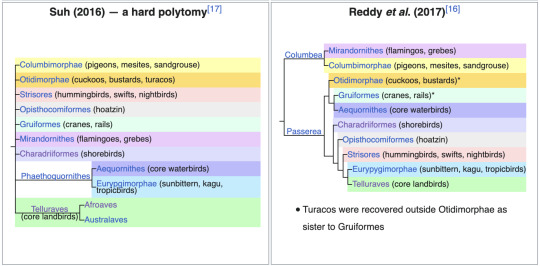

The hard part is getting people to agree.
12 notes
·
View notes
Text
Modern-type birds share several key traits, such as toothless beaks and fused foot bones. The almost 11,000 living bird species — the paleognaths (flightless birds such as ostriches), anseriformes (waterfowl), galliformes (land fowl) and neoaves (the remaining 95 percent of living bird species) — all share a common ancestor, Field says. “We think that ancestor lived at some time before the end of the Age of Dinosaurs,” he says. But there are very few bird fossils surviving from before the asteroid impact.
3 notes
·
View notes
Text
A Genetic Discovery Has Dramatically Changed Our Understanding of Bird Evolution
New Post has been published on https://petn.ws/YWPVF
A Genetic Discovery Has Dramatically Changed Our Understanding of Bird Evolution
For years, scientists have split neoaves (which make up 95 percent of bird species) into two groups: doves/flamingos and everything else. Now, a pair of new studies suggests that doves and flamingos may be more distantly related that we realized. This new family took shape after the discovery of a biologically “frozen” piece of chromosome […]
See full article at https://petn.ws/YWPVF
#BirdNews
0 notes
Note
when you say we don't know how modern birds are interrelated.... how is that something we don't know about?? we know all these other things about whats related to what but not how birds are related? good lord what is going on in there????
tldr Neoaves didn't have many members at the end cretaceous extinction, it's possible only one made it through. the giant amount of empty niches allowed for Neoavians to diversify rapidly, making their interrelationships a giant mess because it's harder to detect what diverged first via their genes, and the fossil record from that time is nooooot great
63 notes
·
View notes
Text
Ez aztán meglepő: egy genetikai felfedezés drámaian megváltoztatta a madarak evolúciójáról alkotott képünket - Blikk
0 notes
Text
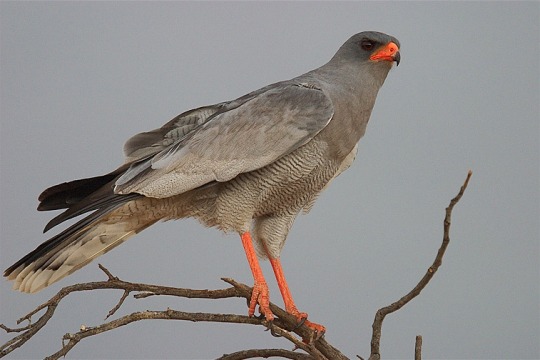
Pale chanting goshawk (Melierax canorus)
Photo by Marion Hogl
#pale chanting goshawk#melierax canorus#melierax#melieraxinae#accipitridae#accipitriformes#accipitrimorphae#afroaves#telluraves#inopinaves#neoaves#neognathae#aves#theropoda#archosauria#sauropsida#reptilia#tetrapoda#vertebrata#chordata
555 notes
·
View notes
Photo
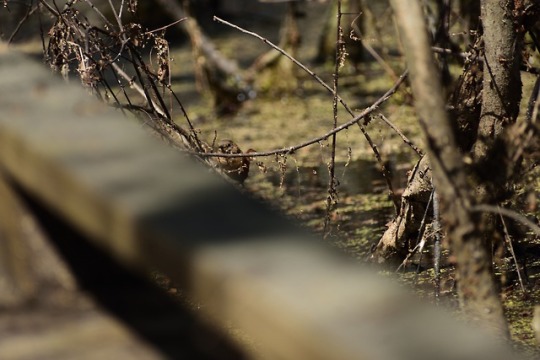
Piece of house wren. It wouldn’t sit still and I won’t have another chance to see one until the fall season.
#house wren#Troglodytes aedon#conservation status: least concern#Animalia#Chordata#Aves#Neornithes#Neognathae#Neoaves#Passeriformes#Passeri#Passerida#Certhioidea#Troglodytidae#Troglodytes#passerine birds#perching birds#wrens#Nikon D3400#nikonphotography#my birbs#Black Bayou Lake National Wildlife Refuge#photographers on tumblr#nature photography#birds of North America#birds of Central America#birds of South America#birds of Canada#birds of Mexico#wildlife
2 notes
·
View notes
Photo

American coot (Fulica americana)
#American coot#Fulica americana#conservation status: least concern#Animalia#Chordata#Aves#Neornithes#Neognathae#Neoaves#Gruiformes#Rallidae#Fulica hesterna#coots#mud hen#birds of North America#rails (birds)#birds of the United States#Nikon D3400#wildlife#Black Bayou Lake National Wildlife Refuge#birds of Central America#North American migratory birds
5 notes
·
View notes